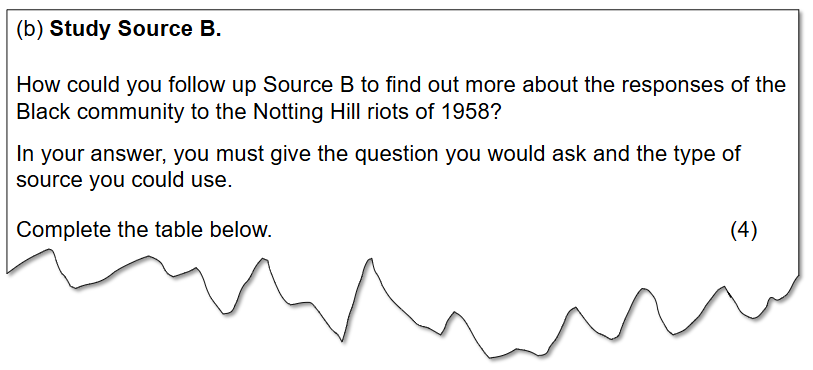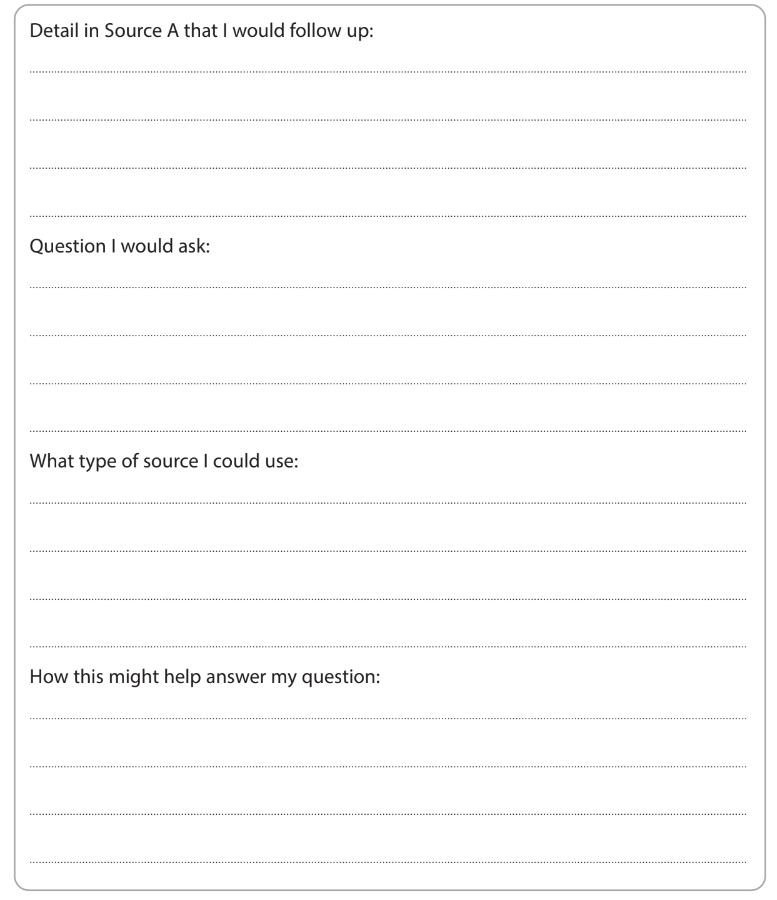The 4 Mark "Follow-up" Question (Edexcel GCSE History): Revision Note
Exam code: 1HI0
Summary of Question 2 (b)
Question 2 (b) tests your ability to:
Select relevant content from a source
Ask a useful historical question based on that content
Suggest a suitable follow-up source
Explain how that source would help answer your question
It always builds on one of the sources from Question 2 (a) and is based on the historic environment: Notting Hill, c1948–c1970
Amount of marks | 4 |
|---|---|
The time that you should spend on the question | No more than 5 minutes |
An example of the type of question you may encounter can be seen below:

In previous years, this question has focused on the following topics in Migrants in Britain:
Year of Exam | Question Topic |
|---|---|
2022 | Caribbean cultures in Notting Hill in the 1960s (opens in a new tab) |
2023 | The problems of housing in Notting Hill in the period c1948–c1970 (opens in a new tab) |
2024 | Black activism in the Notting Hill area |
Key skills required in the "Follow-up" question
The "Follow-up" question uses a very different question style from other questions in the Edexcel GCSE History exam
It requires students to have some of the following key historical skills:
Selecting relevant content from a historical source
Creating a relevant historical question
Selecting historical sources to support your chosen historical question
Using the content of a source
The content is the information presented in the source
The content could come from a variety of different types of sources, such as:
A picture
A photograph
An extract from a book
A speech
A political cartoon
A letter
You should use the content of the source in the first section of your answer table: "Detail in Source ... that I would follow up"
For a written source, use a quote
For a visual source, describe a section of the image
Asking historical questions
The second section is about the "Question I would ask" regarding the source specified in the question
Your question must:
Link to the detail you have just chosen
Be relevant to the enquiry in the question
Be one question
Be written with a question mark
Selecting relevant sources
In the third section of the table, you will be asked to consider: "What type of source I could use"
In this section, avoid selecting sources such as:
Wikipedia
The Internet
A historian
The same type of source as the source identified in the question
For the example question, you should not follow up Source B with another written account
Versatile sources to consider are:
Metropolitan Police records
Notting Hill Housing Trust reports
National newspapers, such as the West Indian Gazette
National TV shows, such as BBC News or ITN
Local newspapers, such as Kensington News
Speeches by people, such as Oswald Mosley
Photographs by Black residents of Notting Hill or in newspapers
Oral histories from Black migrants
Make your source as specific as possible by:
Including dates
Explaining what it could show
In the final section of the table, “How this might help answer my question”, explain:
What you could learn from your chosen source
How it would help you answer the question you asked in Section 2
How to answer the "Follow-up" question
The "Follow-up" answer space is laid out clearly as four guided sections

Section | What to write |
|---|---|
"Detail in Source ... that I would follow up" | A quote from (written) or description of (visual) the source (1) |
"Question I would ask" | One historical question linked to the detail and the enquiry (1) |
"What type of source I could use" | A specific, historical source (1) |
"How this might help answer my question" | A clear explanation of how the source would help answer your question (1) |
Sections 1 and 2 are connected
If you do not provide a detail from the source selected, you will not receive a mark for your question
Sections 3 and 4 are also joined together
If you do not select a relevant source, you cannot receive a mark for how that source can help you to answer your historical question
Worked example of a "Follow-up" question
Worked Example
2 (b) Study Source B.
How could you follow up on Source B to find out more about the responses of the Black community to the Notting Hill riots of 1958?
In your answer, you must give the question you would ask and the type of source you could use.
Complete the table below.
(4)
![Source B: An eyewitness statement by Detective Sergeant Walters, a member of the Metropolitan Police who was on duty on the third day of the Notting Hill Riots. The Metropolitan Police requested the report.
“What can only be described as a mob [of black men] were shouting threats and abuse, and openly displaying various most offensive weapons, ranging from iron bars to choppers and open razors. Denton Boyd in particular had a chopper in his hand and was shouting: 'Come and fight,' and, 'What about it now?"'](https://cdn.savemyexams.com/cdn-cgi/image/f=auto,width=3840/https://cdn.savemyexams.com/uploads/2025/07/54957_source-b-migrants.png)
Answer
Detail in Source B that I would follow up: “Come and fight.” (1)
Question I would ask: Why did some members of the Black community threaten the police during the Notting Hill Riots? (1)
What type of source I could use: Police interviews from Black residents arrested in the Notting Hill Riots in September 1958. (1)
How this might help answer my question: The police interviews may contain Black residents explaining the reasons why they threatened the police and whether this was general violence or self-defence. (1)

Unlock more, it's free!
Did this page help you?